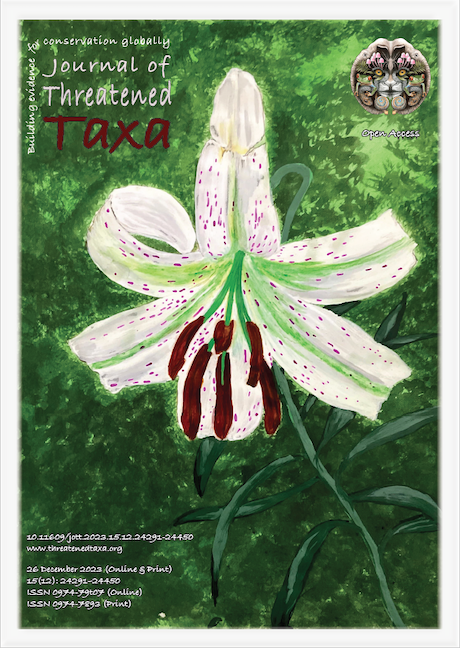Legumes (Fabaceae) from Satmala hills, Maharashtra, India
Main Article Content
Abstract
A floristic survey was carried out in Satmala hill range of Nasik district. The study area is dry throughout the year except monsoon period. During this survey, the authors recorded 74 taxa of the family Fabaceae or Leguminosae, belonging to three subfamilies and 38 genera. The majority of the legumes are herbs & shrubs, while few are climbers & trees. Updated nomenclature, habit, habitat, life forms, GPS coordinates, phenology, voucher specimens & images of legumes found in the study area are provided.
Article Details

This work is licensed under a Creative Commons Attribution 4.0 International License.
Authors own the copyright to the articles published in JoTT. This is indicated explicitly in each publication. The authors grant permission to the publisher Wildlife Information Liaison Development (WILD) Society to publish the article in the Journal of Threatened Taxa. The authors recognize WILD as the original publisher, and to sell hard copies of the Journal and article to any buyer. JoTT is registered under the Creative Commons Attribution 4.0 International License (CC BY), which allows authors to retain copyright ownership. Under this license the authors allow anyone to download, cite, use the data, modify, reprint, copy and distribute provided the authors and source of publication are credited through appropriate citations (e.g., Son et al. (2016). Bats (Mammalia: Chiroptera) of the southeastern Truong Son Mountains, Quang Ngai Province, Vietnam. Journal of Threatened Taxa 8(7): 8953–8969. https://doi.org/10.11609/jott.2785.8.7.8953-8969). Users of the data do not require specific permission from the authors or the publisher.
References
Auti, S.G., S.S. Kambale, K.V.C. Gosavi & A.N. Chandore (2020). Floristic diversity of Anjaneri hills, Maharashtra, India. Journal of Threaten Taxa 12(10): 16295–16313. https://doi.org/10.11609/jott.3959.12.10.16295-16313 DOI: https://doi.org/10.11609/jott.3959.12.10.16295-16313
Cherian, P.J. & R.D. Pataskar (1969). Contribution to the flora of Saptashrungi and adjoining hills, Maharashtra. Nelumbo, The Bulletin of Botanical Survey of India 11(1–2): 23–34
Cooke, T. (1958). The Flora of the Presidency of Bombay (Reprint Editon). Vol. 1. Taylor and Francis, London, 645 pp.
FAO (2016). https://www.fao.org/faostat/en/#home. Accessed on 24 August 2022.
Hooker, J.D. (Ed.) (1876). The Flora of British India 2(4): 56–240. L. Reeve & Co., Henrietta Street, London, 792 pp.
Jain, S.K. & R.R. Rao (1976). A Hand Book of Field and Herbarium Methods. Today and Tomorrow’s Printers and Publishers, New Delhi, 157 pp.
LPWG (2017). A new subfamily classificaton of the Leguminosae based on a taxonomically comprehensive phylogeny. Taxon 66(1): 44–77. https://doi.org/10.12705/661.3 DOI: https://doi.org/10.12705/661.3
Lakshminarasimhan, P. & B.D. Sharma (1991). Flora of Nasik District. Botanical Survey of India, Calcutta, 644 pp.
Naik, V.N. (1998). Flora of Marathwada. Vol. 1. Amrut Prakashan, Aurangabad, 602 pp.
Pawar, B.R. & D.S. Pokle (2011). Flora of hills of Nashik district. PhD Thesis. Department of Botany, Dr. Babasaheb Ambedkar Marathwada University, Aurangabad, 191 pp
Popelka, J.C., N. Terryn & T.H.V. Higgins (2004). Gene technology for grain legumes: can it contribute to the food challenge in developing countries? Plant Science 167: 195–206. DOI: https://doi.org/10.1016/j.plantsci.2004.03.027
Sanjappa, M. (2020). Fabaceae (Leguminosae), pp. 300–446. In: Mao, A.A. & S.S. Dash (eds.). Flowering Plants of India an Annotated Checklist Dicotyledons. Botanical Survey of India, Kolkata, 705 pp.
Singh, N.P. & S. Karthikeyan (2001). Flora of Maharashtra State. Vol. 1. Botanical Survey of India, Calcutta, 916 pp.
USDA (1998). Legumes and Soil Quality. Soil Quality–agronomy Technical Note 6: 1–3.
Yadav, S. & P.B. Dhanke (2010). A Checklist of Plants of Nashik District. Orient Press Ltd, Mumbai, 143 pp.

